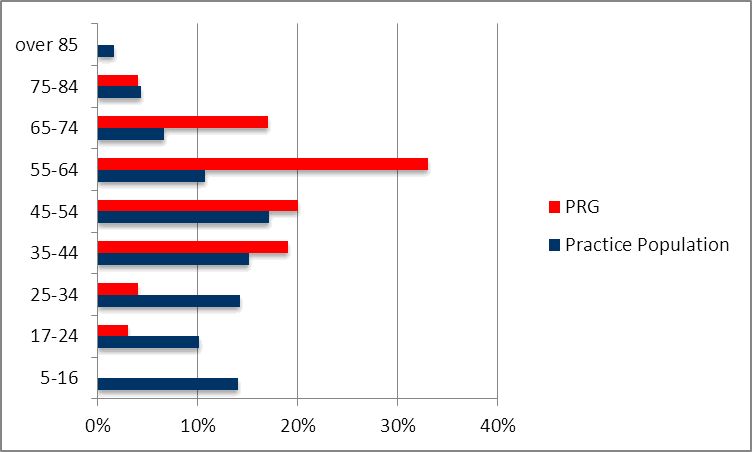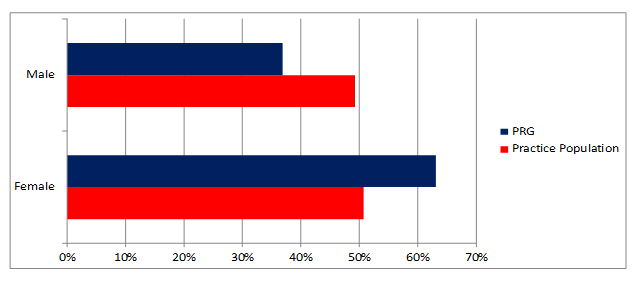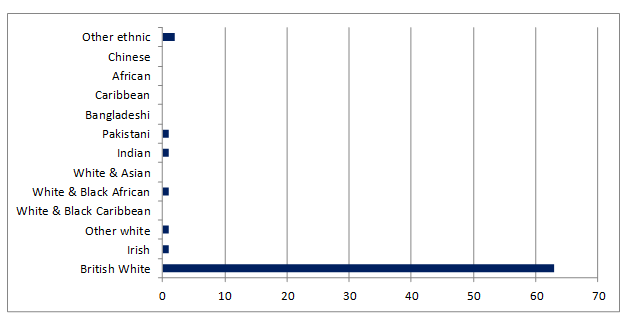Key Objectives
In April 2011, GP Practices were encouraged to set up a Patient Representative Group through the Patient Participation Enhanced Service. The purpose of this Enhanced Service is to ensure that patients are involved in decisions about the range and quality of services provided and, over time, commissioned by their practice. It aims to encourage and reward GP Practices for routinely asking for and acting on the views of their patients. This includes patients being involved in decisions that lead to changes to the services their practice provides or commissions, either directly or in its capacity as gatekeeper to other services. The Enhanced Service aims to promote the proactive engagement of patients through the use of effective Patient Reference Groups (PRGs) and to seek views from practice patients through the use of a local practice survey. The outcomes of the engagement and the views of patients are to be published on the practice website.
Establishing A PRG At Caritas GP Partnership
The management of Caritas GP Partnership is carried out jointly by the Partners and the Business Manager, Tanya Humphreys. However, patients are registered with one Practice and each Practice operates a different appointment system, e.g. Dial House Medical Centre offers an open surgery every morning, whereas Ellesmere Medical Centre has a triage system in place to deal with any urgent queries. Furthermore, the Practices are placed in different areas of Stockport so their Practice population is also considerably different.
After much consideration, in April 2011, it was decided that separating the responses from patients at each Practice would allow us to identify differences in patient satisfaction between the two Practices and would enable us to focus on issues that were specific to each Practice. Therefore, we effectively set up and ran a PRG for each Practice. This proved to be very successful in 2011/2012 and 2012/2013 and so we carried it through to 2013/2014. Interestingly, the members of both PRGs chose once again to focus on the same 5 areas for the local patient survey; therefore, we used the same questionnaire across both Practices. The format used to analyse and report on the findings of each PRG is the same; the main differences are in the actions plans (see below). To ensure credibility of our local practice survey we engaged with the PRG to establish the focus of our questionnaire, which we then made available on our websites and in our waiting rooms. This process provided access to the questionnaire for all of our patients. The answers were then carefully input into our practice websites which then provided us with the raw data enabling us to produce the pie charts shown in the report.
This is the 2013/2014 Patient Representative Group Report for Caritas GP Partnership, which summarises the development and outcomes of the PRGs at Dial House Medical Centre and Ellesmere Medical Centre.
The following section focuses on Ellesmere Medical Centre. All the information regarding Dial House Medical Centre can be found further down in this report.
This is the 2013/2014 Patient Representative Group Report for Caritas GP Partnership.
Caritas GP Partnership includes Dial House Medical Centre and Ellesmere Medical Centre.
We conducted our survey across both practices and have produced individual reports, which we have combined and are shown below.
Caritas GP Partnership
(Ellesmere Medical Centre)
Patient Representative Group (PRG) Report
This report summarises the development and outcomes of Ellesmere Medical Centre’s PRG (2013/14)
On-going promotion of our PRG
To build on last year’s creation of our PRG, we have continued to recruit members. This has been achieved by attaching membership forms to new patient registration forms and placing these forms on our front reception desk for existing patients. As a result of this ongoing promotion, we have recruited 5 new members, bringing our total to 70. From this figure we have 2 who expressed a preference for a face to face meeting, 59 that preferred a virtual group and 9 who stated no preference.
As new members joined the PRG, we added their details to our PRG database. We monitored how representative our group was on a monthly basis and accordingly with our findings, we targeted the groups that had low or no representation, ie men and young people, via reception, opportunistically asking these groups if they would be interested in joining the PRG. We also telephoned younger patients asking if they would be interested in joining the group. To date we have recruited 2 young patients.
Profile
The graphs below show the age, sex and ethnicity profile of our PRG compared to our Practice population.
Age Profile

The above chart shows that the PRG distribution is fairly consistent with our Practice population in some age ranges. Nonetheless, the percentage of PRG members in the 17-24 age range is slightly below our expectations; however we are pleased to note that this has increased since last year. We realise that this age group are less likely to come into the practice regularly and are therefore, harder to engage. We will continue to focus on this category with a view to increase their representation.
PRG Breakdown
| Age & Sex breakdown |
Male |
Female |
| Under 16 |
0 |
0 |
| 17 – 24 |
0 |
2 |
| 25 – 34 |
0 |
3 |
| 35 – 44 |
4 |
8 |
| 45 – 54 |
9 |
4 |
| 55 – 64 |
8 |
15 |
| 65 – 74 |
5 |
9 |
| 75 – 84 |
3 |
0 |
| Over 84 |
0 |
0 |
Comparative Sex Profile

The male/female ratio of our Practice population is even. However, the male representation in our PRG is significantly below the female representation. We identified this as an issue shortly after we started recruiting members and even though we proactively targeted male patients, the female representation is still predominant. We will continue to encourage male patients to join our Group.
The data we hold on ethnicity is incomplete and cannot be used for comparison purposes. The chart below shows that most of our PRG members are white British (91%), which we believe to be a fair representation of our practice population.
Ethnicity Profile

Following on from last year, where we identified carers as a hard to reach group and recruited 5 patients, we contacted this cohort to ensure that they were still happy to remain members of the PRG and got a positive response from all. We also again looked at our list of patients coded as carers and contacted a number from this list. A number of patients expressed an interest in joining the PRG and application forms were sent out. This year we also targeted patients who are resident at our local drug and alcohol treatment centre. These patients are a hard to reach group because they are often new to the area and due to their problems are difficult to engage. A search was performed to identify these patients. We then contacted the support worker at the treatment centre and explained the PRG concept to him and asked if he would be willing to act as an intermediary between the residents and the practice. He agreed to this so we sent him a PRG application form, which included a sentence giving consent for him to act as the patient’s representative. To date we have yet to recruit anyone from this group.
1. Practice Survey
We contacted all our PRG members, either via email or by letter, with a list of proposed survey options, asking them to choose 5 subjects from a possible 11 on which to survey our patients (see below).
PRG proposed survey options (PDF, 15KB)
The 5 most popular choices were: waiting times, telephone answering and access, patient information, opening times and on-line prescription ordering. We, therefore, created a comprehensive questionnaire based on these subjects, having also consulted the National Patient Survey, as it is a well recognised survey tool. This questionnaire was then sent out to the PRG members, asking for input on any amendments/additions.
PRG questionnaire (PDF, 82KB)
Once we had received feedback from our PRG members we made the questionnaire available both at the Practice and on our website. The questionnaires were handed out to patients during surgery. A total of 250 questionnaires were handed out during clinic sessions.
In total, we received 203 completed questionnaires.
On receipt of the completed questionnaires we analysed the data and produced a report with the results, which included an easy to follow pie chart formula. This was sent out to our PRG members, giving them the opportunity for comment and to give their opinions on how we should move forward with this information. It is important to note that our survey did not point to the desire for significant change in any of the services we provide, or the way in which services are provides.
The embedded document below contains full details of all questions included in our survey and is the document that was forwarded to our PRG members:
Survey Results (PDF, 439KB)
All feedback was positive with no disagreements. We also encouraged patients to provide us with feedback by completing a form and placing it in our suggestion box, which is checked by Tracy Johnstone (Assistant Practice Manager) on a weekly basis. This has so far not proven to be very successful and it is rarely used by our patients. However we will continue to advertise it.
We then wrote the following action plan, which also informed members on how our actions from last year had been implemented:
Action Plan (PDF, 102KB)
Finally, we sent it to all our PRG members asking them to comment and make suggestions on the following proposed actions. Once again, all feedback was positive with no disagreements. Therefore, because there have been no changes which impact on contractual arrangements there has been no need to inform NHS England.
Waiting Times
These results will be discussed with the clinical team at our next Training and Development session to find out if there is something that can be done to reduce waiting times. It is important to note, however, that all our doctors strive to run their clinics on time and that when they run late, it is often due to the fact that they may have had to either deal with an emergency or spend more time than the allocated ten minute slot with a patient.
Telephone Answering and Access
We are aware that during busy times patients sometimes may have to wait a while for the telephone to be answered. Our new arrival screen is up and running therefore freeing up receptionists time. We also endeavour to reduce our receptionists’ work load to enable them more time for answering calls.
All of our dedicated nursing team have been advised to pass on information during a blood test appointment to the patient of how they can obtain their results after 2pm. We will also continue to advertise this in the waiting room and on our website.
Online prescription ordering
These figures have dropped from last year which tells us that our advertising campaign for this service has worked. We will continue to advertise not only in our waiting room and on our website but we will add this information to our prescriptions for all patients to see.
Patient information
These results are very positive and will be passed on to our reception team.
Opening hours
This service has been advertised on posters around the waiting room in the past. We have decided to dedicate a notice board specifically for advertising our early mornings and Saturday clinics. We are also going to place it in a prominent position on our website and practice booklet.
Feedback
The feedback we received was very positive and some PRG members congratulated us on the positive survey results. There was no disagreement and there are no contractual considerations to the agreed actions.
The report is now available here there are 2 hard copies available for our patients to read in our waiting room.
Practice opening hours
Monday: 8.00am to 6.00pm
Tuesday: 7.00am to 6.00pm
Wednesday: 8.00am to 6.00pm
Thursday: 7.00am to 6.00pm
Friday: 8.00am to 6.00pm
One Saturday per month: 9.00am to 12.00pm
Appointments may be booked in person, online or by telephone.
The surgery is open on Tuesdays and Thursdays from 7am to 8am for patients who work. Both Dr Webster and Dr McGuigan are available at that time as well as a Practice Nurse and a Health Care Assistant on a Thursday
Either Dr Webster or Dr McGuigan is available between 9am and 12pm one Saturday every month.